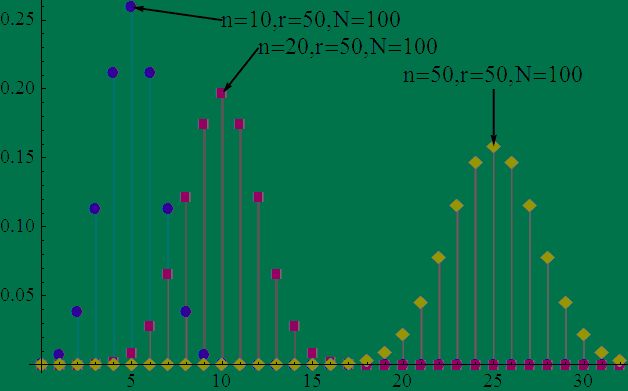博文
The Hypergeometric Probability Distribution(超几何分布)
|||
A hypergeometric experiment possesses the following properties:
1. A population contains a finite number $N$ of elements that possess one of two characteristics, say, red and black.
2. $r$ of the elements are red and the others black.
1. A population contains a finite number $N$ of elements that possess one of two characteristics, say, red and black.
2. $r$ of the elements are red and the others black.
3. A sample of n elements is randomly selected from the population.
4. The random variable of interest is Y , the number of red elements in the sample.
Definition:
A random variable Y is said to have a hypergeometric probability distribution if and only if
$$p(y) = frac{{left( {begin{array}{*{20}{c}} r\ y end{array}} right)left( {begin{array}{*{20}{c}} {N - r}\ {n - y} end{array}} right)}}{{left( {begin{array}{*{20}{c}} N\ n end{array}} right)}}$$
where $y$ is an integer 0, 1, 2, ..., n, subject to the restrictions $y \le r$ and $n-y \le N-r$.
You can use the following Mathematica command to obtain the probability
PDF[HypergeometricDistribution[n, r, N], y] // TraditionalForm
Relative Mathematica Function
HypergeometricDistribution[n, r, N] Gives the distribution of the number of red elements in n draws from a population of size N containing r red elements.
Examples:
A[n_] := HypergeometricDistribution[n, 50, 100];
a1 = {Arrowheads[0.02], Arrow[{{10, 0.25}, {5, PDF[A[10], 5]}}]};
t1 = Text[Style["n=" <> ToString[10] <> ",r=50,N=100", Medium], {10, 0.25}, {-1, 0}];
a2 = {Arrowheads[0.02], Arrow[{{12, 0.23}, {10, PDF[A[20], 10]}}]};
t2 = Text[Style["n=" <> ToString[20] <> ",r=50,N=100", Medium], {12, 0.23}, {-1, 0}];
a3 = {Arrowheads[0.02], Arrow[{{25, 0.20}, {25, PDF[A[50], 25]}}]};
t3 = Text[Style["n=" <> ToString[50] <> ",r=50,N=100", Medium], {25, 0.20}, {0, -1}];
epilog = {a1, t1, a2, t2, a3, t3};
DiscretePlot[Evaluate@Table[PDF[A[n], k], {n, {10, 20, 50}}], {k, 0, 32},
PlotRange -> All, PlotMarkers -> Automatic, Epilog -> epilog,
Background -> RGBColor[0.1, 0.45, 0.3, 0.9]]
a1 = {Arrowheads[0.02], Arrow[{{10, 0.25}, {5, PDF[A[10], 5]}}]};
t1 = Text[Style["n=" <> ToString[10] <> ",r=50,N=100", Medium], {10, 0.25}, {-1, 0}];
a2 = {Arrowheads[0.02], Arrow[{{12, 0.23}, {10, PDF[A[20], 10]}}]};
t2 = Text[Style["n=" <> ToString[20] <> ",r=50,N=100", Medium], {12, 0.23}, {-1, 0}];
a3 = {Arrowheads[0.02], Arrow[{{25, 0.20}, {25, PDF[A[50], 25]}}]};
t3 = Text[Style["n=" <> ToString[50] <> ",r=50,N=100", Medium], {25, 0.20}, {0, -1}];
epilog = {a1, t1, a2, t2, a3, t3};
DiscretePlot[Evaluate@Table[PDF[A[n], k], {n, {10, 20, 50}}], {k, 0, 32},
PlotRange -> All, PlotMarkers -> Automatic, Epilog -> epilog,
Background -> RGBColor[0.1, 0.45, 0.3, 0.9]]
https://blog.sciencenet.cn/blog-531885-597654.html
上一篇:The Negative Binomial Probability Distribution(负二项分布)
下一篇:Mathematica中的With,Module及Block的用法及区别
